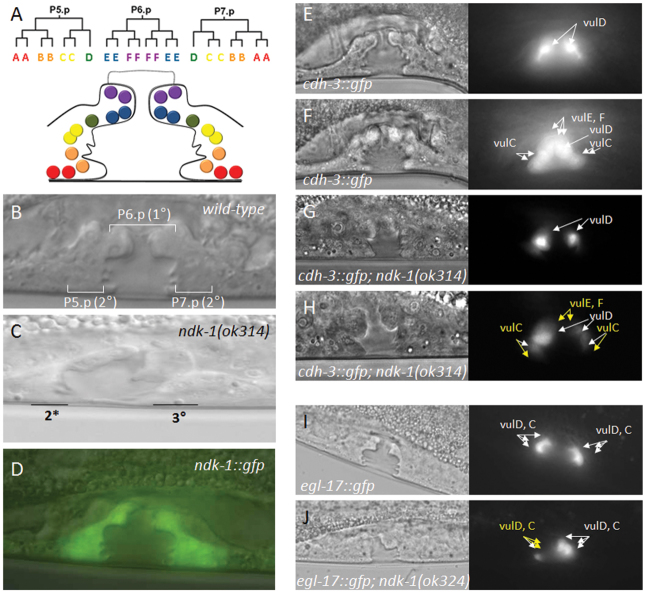Fig. 3.
ndk-1(ok314) mutants display defects in vulval development. (A) The wild-type, mid-L4 stage vulva is composed of 22 cells, which can be grouped into seven cell types (vulA, B1, B2, C, D, E and F). These cells are the great-granddaughters of P5.p-P7.p VPCs (blue and violet circles, primary lineages; red, orange, yellow and green circles, secondary lineages). (B,C) The vulva structure of a wild-type (N2) mid-L4 stage larva (B) and an ndk-1(ok314) mutant mid-L4 stage larva (C). The mutant vulval structure is not symmetrical. (D) A transcriptional ndk-1::gfp reporter is expressed in the developing vulva of an L4 stage larva. (E-H) cdh-3::gfp is a marker for vulD, C, E and F cells (white arrows) at the L4 stage. Each figure consists of a fluorescent image (right) of cdh-3::gfp expression and a DIC image (left) of the corresponding focal plane. (E,F) cdh-3::gfp expression in a wild-type worm in two different focal planes: the focal plane of vulD cells (E) and that of vulC, E and F cells (F). (G,H) In an ndk-1(ok314) homozygote, vulD cells are present (G, white arrows), but vulE and F cells are missing (H, yellow arrows). (I,J) Expression pattern of the Ras/MAPK pathway target gene egl-17 in a wild-type mid-stage L4 larva (I) and in an ok314 mutant L4 stage larva (J). Both comprise a fluorescent image (right) of egl-17::gfp expression and a DIC image (left) of the corresponding focal plane. The ndk-1 mutant shows reduced expression of egl-17::gfp, indicating that Ras/MAPK signaling is inhibited in the ndk-1(-) mutant background; white arrows indicate correctly specified vulval cells, yellow arrows show the position of non-fluorescent vulval cells that would normally express egl-17.

